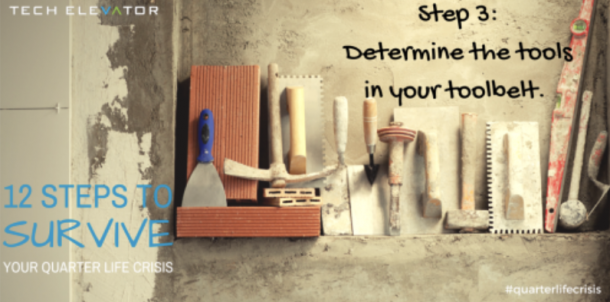Surviving Your Quarter Life Crisis: Step 3
 Step #3: Determine the Tools in Your Toolbelt
Step #3: Determine the Tools in Your Toolbelt
As we’ve determined, finding a fulfilling career path is the key to conquering your quarter-life crisis.
Of course, finding a dream job doesn’t happen overnight. In fact, even figuring out what your ideal career path is (or looks like) isn’t easy, especially because you’re not even aware yet of the tools you already have at your disposal.
So how can you define the tools in your personal toolbelt that will help you decide what’s important to you and your career? A good first step is embarking on a period of intense introspection.
One helpful resource we love is Danielle Laporte’s The Desire Map. This book doubles as a philosophy which focuses on helping people establish a life plan by focusing on achieving core desired feelings rather than specific, tangible milestones.
Basically, figuring out how you want to feel every day will help you direct your short- and long-term moves and actions—because, as Laporte notes, “that kind of inner clarity and outer action” means “decisions will be easier to make.”
Getting to a place where you can access that clarity and be open to new opportunities involves taking a break from the daily grind.
These breaks or “tools” can take many forms, but might include:
- Yoga. A class once or twice a week is a good way to unwind and clear your head.
- Exercise. Getting your blood flowing—whether swimming, a run, a bike ride or a gym trip—helps maintain your emotional and physical health.
- Traveling. Getting out of your usual environment and into a new place often refreshes your perspective and leads to new insights.
- Meditation. Even taking 10 to 15 minutes out of your day to relax and think can help you get rid of nagging stress and inner discord.
- Meetups. Hanging out with other people is a good way to bounce ideas off experts, hear about other opportunities—and put it out there into the world that you’re looking to make a change.
It’s important to remember that there’s no wrong way to unplug from the hectic nature of day-to-day life. Figuring out what works best for you personally—and then committing to doing so on a consistent basis—is more important.
After all, sustained, prolonged reflection is the way to achieve the kind of self-awareness needed to overcome your quarter-life crisis.
Now that you’ve figured out your core tools, what are the best next steps to take? How can you make this your best year yet? Follow us for quarter-life crisis survival tips and guidance, including step #4, published in a few weeks.